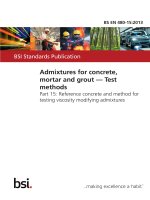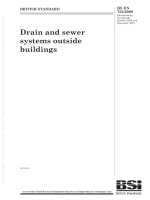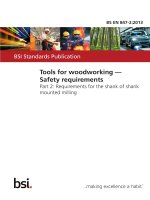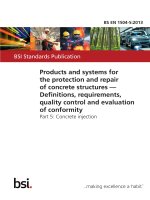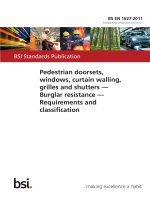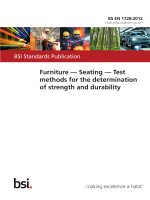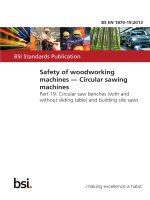Bsi bs en 61788 18 2013
Bạn đang xem bản rút gọn của tài liệu. Xem và tải ngay bản đầy đủ của tài liệu tại đây (1.96 MB, 42 trang )
BS EN 61788-18:2013
BSI Standards Publication
Superconductivity
Part 18: Mechanical properties
measurement — Room temperature
tensile test of Ag- and/or
Ag alloy-sheathed Bi-2223 and
Bi-2212 composite superconductors
BRITISH STANDARD
BS EN 61788-18:2013
National foreword
This British Standard is the UK implementation of EN 61788-18:2013. It is
identical to IEC 61788-18:2013.
The UK participation in its preparation was entrusted to Technical
Committee L/-/90, Super Conductivity.
A list of organizations represented on this committee can be obtained on
request to its secretary.
This publication does not purport to include all the necessary provisions of
a contract. Users are responsible for its correct application.
© The British Standards Institution 2014.
Published by BSI Standards Limited 2014
ISBN 978 0 580 70783 4
ICS 29.050
Compliance with a British Standard cannot confer immunity from
legal obligations.
This British Standard was published under the authority of the
Standards Policy and Strategy Committee on 31 January 2014.
Amendments/corrigenda issued since publication
Date
Text affected
BS EN 61788-18:2013
EN 61788-18
EUROPEAN STANDARD
NORME EUROPÉENNE
EUROPÄISCHE NORM
December 2013
ICS 29.050
English version
Superconductivity Part 18: Mechanical properties measurement Room temperature tensile test of Ag- and/or Ag alloy-sheathed Bi-2223
and Bi-2212 composite superconductors
(IEC 61788-18:2013)
Supraconductivité Partie 18: Mesure des propriétés mécaniques Essai de traction à température ambiante des
supraconducteurs composites Bi-2223 et
Bi-2212 avec gaine Ag et/ou en alliage d'Ag
(CEI 61788-18:2013)
Supraleitfähigkeit Teil 18: Messung der mechanischen
Eigenschaften Zugversuch von Ag und/oder Ag-Legierung
ummantelten Bi-2223 und Bi-2212
Verbundsupraleitern bei Raumtemperatur
(IEC 61788-18:2013)
This European Standard was approved by CENELEC on 2013-10-17. CENELEC members are bound to comply
with the CEN/CENELEC Internal Regulations which stipulate the conditions for giving this European Standard
the status of a national standard without any alteration.
Up-to-date lists and bibliographical references concerning such national standards may be obtained on
application to the CEN-CENELEC Management Centre or to any CENELEC member.
This European Standard exists in three official versions (English, French, German). A version in any other
language made by translation under the responsibility of a CENELEC member into its own language and notified
to the CEN-CENELEC Management Centre has the same status as the official versions.
CENELEC members are the national electrotechnical committees of Austria, Belgium, Bulgaria, Croatia, Cyprus,
the Czech Republic, Denmark, Estonia, Finland, Former Yugoslav Republic of Macedonia, France, Germany,
Greece, Hungary, Iceland, Ireland, Italy, Latvia, Lithuania, Luxembourg, Malta, the Netherlands, Norway, Poland,
Portugal, Romania, Slovakia, Slovenia, Spain, Sweden, Switzerland, Turkey and the United Kingdom.
CENELEC
European Committee for Electrotechnical Standardization
Comité Européen de Normalisation Electrotechnique
Europäisches Komitee für Elektrotechnische Normung
CEN-CENELEC Management Centre: Avenue Marnix 17, B - 1000 Brussels
© 2013 CENELEC -
All rights of exploitation in any form and by any means reserved worldwide for CENELEC members.
Ref. No. EN 61788-18:2013 E
BS EN 61788-18:2013
EN 61788-18:2013
-2-
Foreword
The text of document 90/326/FDIS, future edition 1 of IEC 61788-18, prepared by IEC/TC 90
"Superconductivity" was submitted to the IEC-CENELEC parallel vote and approved by CENELEC as
EN 61788-18:2013.
The following dates are fixed:
–
latest date by which the document has to be implemented at
national level by publication of an identical national
standard or by endorsement
(dop)
2014-07-17
–
latest date by which the national standards conflicting with
the document have to be withdrawn
(dow)
2016-10-17
Attention is drawn to the possibility that some of the elements of this document may be the subject of
patent rights. CENELEC [and/or CEN] shall not be held responsible for identifying any or all such
patent rights.
Endorsement notice
The text of the International Standard IEC 61788-18:2013 was approved by CENELEC as a European
Standard without any modification.
In the official version, for Bibliography, the following notes have to be added for the standards indicated:
IEC 61788-6
NOTE
Harmonized as EN 61788-6.
ISO 3611:2010
NOTE
Harmonized as EN ISO 3611:2010 (not modified).
-3-
BS EN 61788-18:2013
EN 61788-18:2013
Annex ZA
(normative)
Normative references to international publications
with their corresponding European publications
The following documents, in whole or in part, are normatively referenced in this document and are
indispensable for its application. For dated references, only the edition cited applies. For undated
references, the latest edition of the referenced document (including any amendments) applies.
NOTE When an international publication has been modified by common modifications, indicated by (mod), the
relevant EN/HD applies.
Publication
IEC 60050
Year
series
Title
International Electrotechnical Vocabulary
EN/HD
-
Year
-
ISO 376
-
Metallic materials - Calibration of forceproving instruments used for the
verification of uniaxial testing machines
EN ISO 376
-
ISO 6892-1
-
Metallic materials - Tensile testing
Part 1: Method of test at room temperature
EN ISO 6892-1
-
ISO 7500-1
-
Metallic materials - Verification of static
uniaxial testing machines
Part 1: Tension/compression testing
machines - Verification and calibration of
the force-measuring system
EN ISO 7500-1
-
ISO 9513
-
Metallic materials - Calibration of
extensometer systems used in uniaxial
testing
EN ISO 9513
-
–2–
BS EN 61788-18:2013
61788-18 © IEC:2013
CONTENTS
1
Scope ............................................................................................................................... 7
2
Normative references ....................................................................................................... 7
3
Terms and definitions ....................................................................................................... 7
4
Principle ........................................................................................................................... 9
5
Apparatus ......................................................................................................................... 9
6
5.1 General ................................................................................................................... 9
5.2 Testing machine ...................................................................................................... 9
5.3 Extensometer .......................................................................................................... 9
Specimen preparation ....................................................................................................... 9
7
6.1 General ................................................................................................................... 9
6.2 Length of specimen ............................................................................................... 10
6.3 Removing insulation .............................................................................................. 10
6.4 Determination of cross-sectional area (S 0 ) ............................................................ 10
Testing conditions .......................................................................................................... 10
8
7.1 Specimen gripping ................................................................................................. 10
7.2 Setting of extensometer ......................................................................................... 10
7.3 Testing speed ........................................................................................................ 10
7.4 Test ....................................................................................................................... 10
Calculation of results ...................................................................................................... 12
9
8.1 Modulus of elasticity (E) ........................................................................................ 12
8.2 0,2 % proof strength (R p 0,2 ) ................................................................................ 13
8.3 Tensile stress at specified strains (R A ) .................................................................. 13
8.4 Fracture strength (R f ) ............................................................................................ 14
Uncertainty of measurement ........................................................................................... 14
10 Test report ...................................................................................................................... 14
10.1
10.2
10.3
Annex A
Specimen .............................................................................................................. 14
Results .................................................................................................................. 15
Test conditions ...................................................................................................... 15
(informative) Additional information relating to Clauses 1 to 14 .............................. 16
Annex B (informative) Uncertainty considerations ................................................................ 26
Annex C (informative) Specific examples related to evaluation of uncertainties for
Ag/Bi-2223 and Ag/Bi-2212 wires ................................................................................... 30
Figure 1 – Typical stress-strain curve and definition of modulus of elasticity and 0,2 %
proof strengths of an externally laminated Ag/Bi-2223 wire by brass foil ............................... 11
Figure 2 – Typical stress-strain curve of an Ag/Bi-2223 wire where the 0,2 % proof
strengths could not be determined and definition of tensile stresses at specified strains ....... 12
Figure A.1 – Low mass Siam twin type extensometer with a gauge length of ~ 12,3 mm
(total mass ~ 0,5 g) ............................................................................................................... 16
Figure A.2 – Low mass double extensometer with a gauge length of ~ 25,6 mm (total
mass ~ 3 g) ........................................................................................................................... 17
Figure A.3 – An example of the extensometer provided with balance weight and vertical
specimen axis ....................................................................................................................... 18
Figure A.4 – Original raw data of an Ag/Bi-2223 wire measurement in form of load and
displacement graph ............................................................................................................... 19
BS EN 61788-18:2013
61788-18 © IEC:2013
–3–
Figure A.5 – Typical stress versus strain of an Ag/Bi-2223 wire up to the elastic limit
corresponding to the transition region from elastic to plastic deformation (point G) ............... 20
Figure C.1 – Measured stress versus strain curve for Bi-2223 wire ....................................... 31
Table A.1 – Results of relative standard uncertainty values achieved on different
Ag/Bi-2223 wires during the international round robin tests ................................................... 23
Table A.2 – Selected data for F test for E 0 of Sample E bare wire ........................................ 24
Table A.3 – Results of F-test for the variations of E 0 of four kinds of Bi-2223 wires .............. 24
Table B.1 – Output signals from two nominally identical extensometers ................................ 27
Table B.2 – Mean values of two output signals ..................................................................... 27
Table B.3 – Experimental standard deviations of two output signals ...................................... 27
Table B.4 – Standard uncertainties of two output signals ...................................................... 27
Table B.5 – Coefficient of variations of two output signals ..................................................... 28
Table C.1. – Load cell specifications according to manufacturer’s data sheet........................ 32
Table C.2 – Uncertainties from various factors for stress measurement ................................ 33
Table C.3 – Uncertainties with respect to measurement of strain measurement .................... 35
Table C.4 – Summary of evaluated uncertainties caused by various factors .......................... 35
Table C.5 – Results of uncertainty evaluation for the modulus of elasticity (E 0 = 86,1
GPa) as a function of initial cross head rate .......................................................................... 36
Table C.6 – Uncertainties from various factors for stress measurement ................................ 37
Table C.7 – Results of uncertainty evaluation for the stress (R = 42,5 MPa) as a function
of initial strain rate ................................................................................................................ 37
–6–
BS EN 61788-18:2013
61788-18 © IEC:2013
INTRODUCTION
Several types of composite superconductors have now been commercialised. Especially, high
temperature superconductors such as Ag- and/or Ag alloy-sheathed Bi-2223 (Ag/Bi-2223) and
Ag- and/or Ag alloy-sheathed Bi-2212 (Ag/Bi-2212) wires are now manufactured in industrial
scale. Commercial composite superconductors have a high current density and a small
cross-sectional area. The major applications of composite superconductors are to build
electrical power devices and superconducting magnets. While the magnet is being
manufactured, complicated stresses/strains are applied to its windings and, while it is being
energized, a large electromagnetic force is applied to the superconducting wires because of its
high current density. It is therefore indispensable to determine the mechanical properties of the
superconductive wires from which the windings are made.
The Ag/Bi-2223 and Ag/Bi-2212 superconductive composite wires fabricated by the powder-in
-tube method are composed of a number of oxide filaments with silver and silver alloy as a
stabilizer and supporter. In the case that the external reinforcement of Ag/Bi-2223 and
Ag/Bi-2212 wires by using thin stainless or Cu alloy foils has been adopted in order to resist the
large electromagnet force, this standard shall be also applied.
BS EN 61788-18:2013
61788-18 © IEC:2013
–7–
SUPERCONDUCTIVITY –
Part 18: Mechanical properties measurement –
Room temperature tensile test of Ag- and/or Ag alloy-sheathed
Bi-2223 and Bi-2212 composite superconductors
1
Scope
This International Standard specifies a test method detailing the tensile test procedures to be
carried out on Ag/Bi-2223 and Ag/Bi-2212 superconductive composite wires at room
temperature.
This test is used to measure the modulus of elasticity and to determine the 0,2 % proof strength.
When the 0,2 % proof strength could not be determined due to earlier failure, the stress level at
apparent strains of 0,05 %, 0,1 %, 0,15 %, 0,2 %, 0,25 % with increment of 0,05 % is measured.
The values for elastic limit, fracture strength, percentage elongation after fracture and the fitted
type of 0,2 % proof strength serve only as a reference (see Clauses A.4, A.5, A.6 and A.10).
The sample covered by this test procedure should have a round or rectangular cross-section
with an area of 0,3 mm 2 to 2,0 mm 2 (corresponding to the tape-shaped wires with width of 2,0
mm to 5,0 mm and thickness of 0,16 mm to 0,4 mm).
2
Normative references
The following documents, in whole or in part, are normatively referenced in this document and
are indispensable for its application. For dated references, only the edition cited applies. For
undated references, the latest edition of the referenced document (including any amendments)
applies.
IEC 60050
(all
parts),
International
<>)
Electrotechnical
Vocabulary
(available
at
ISO 376, Metallic materials – Calibration of force-proving instruments used for the verification of
uniaxial testing machines
ISO 6892-1, Metallic materials – Tensile testing – Part 1: Method of test at room temperature
ISO 7500-1, Metallic materials – Verification of static uniaxial testing machines – Part 1:
Tension/compression testing machines – Verification and calibration of the force-measuring
system
ISO 9513, Metallic materials – Calibration of extensometer systems used in uniaxial testing
3
Terms and definitions
For the purposes of this document, terms and definitions given in IEC 60050-815 and
ISO 6892-1, as well as the following terms and definitions apply.
–8–
BS EN 61788-18:2013
61788-18 © IEC:2013
3.1
tensile stress
R
tensile force divided by the original cross-sectional area at any moment during the test
3.2
tensile strain
A
displacement increment divided by initial gauge length of extensometers at any moment during
the test
3.3
extensometer gauge length
LG
length of the parallel portion of the test piece used for the measurement of displacement by
means of an extensometer
3.4
distance between grips
Lo
length between grips that hold a test specimen in position before the test is started
3.5
modulus of elasticity
E
gradient of the straight portion of the stress-strain curve in the elastic deformation region
SEE: Figure 1.
Note 1 to entry: It can be determined differently depending upon the adopted procedures:
a)
one from the initial loading curve by zero offset line expressed as E 0 ,
b)
the other one given by the slope of line during the elastic unloading, expressed as E U .
3.6
0,2 % proof strength
R p0,2
stress value when the superconductive composite wire yields by 0,2 %
SEE: Figure 1.
Note 1 to entry: The designated stress, R p0,2-0 or R p0,2-U corresponds to point A or B obtained from the initial loading
or unloading curves in Figure 1, respectively. This strength is regarded as a representative 0,2 % proof strength of the
composite.
3.7
tensile stress at specified strains
RA
tensile stress corresponding to different specified strain (A)
3.8
fracture strength
Rf
tensile stress at the fracture
Note 1 to entry:
testing force
In most cases, the fracture strength is defined as tensile stress corresponding to the maximum
BS EN 61788-18:2013
61788-18 © IEC:2013
–9–
3.9
tensile stress at elastic limit
R el
tensile stress at elastic limit corresponding to transition instant from elastic to plastic
deformation
3.10
tensile strain at elastic limit
A el
strain at elastic limit
Note 1 to entry: The stress R el and the corresponding strain A el refer to point G in Figure A.5, respectively and are
regarded as the transition point from elastic to plastic deformation.
4
Principle
The test consists of straining a test piece by a tensile force, generally to fracture, in principle for
the purpose of determining the mechanical properties defined in Clause 3.
Depending on the employed strain measuring method, however, the quantities determined by
the present test should be limited. When using the conventional single extensometer system, the
determination of E U and R p0,2-U is recommended. On the other hand, all quantities described
here can be determined by using double extensometer system, because of its capability to
compensate the bending effects of the specimen thereby guaranteeing a proper determination
of the modulus of elasticity.
5
5.1
Apparatus
General
The test machine and the extensometers shall conform to ISO 7500-1 and ISO 9513,
respectively. The calibration shall obey ISO 376. The special requirements of this standard are
presented here.
5.2
Testing machine
A tensile machine control system that provides a constant crosshead speed shall be used. Grips
shall have a structure and strength appropriate for the test specimen and shall be constructed to
provide a firm connection with the tensile machine. The faces of the grips shall be filed or
knurled, or otherwise roughened, so that the test specimen will not slip during the test. Gripping
may be a screw type, or pneumatically or hydraulically actuated.
5.3
Extensometer
The mass of the extensometer shall be 30 g or less, so as not to affect the mechanical properties
of superconductive composite wires. The mass of the extensometers shall be balanced
symmetrically around the wire to avoid any non-alignment force. Care shall be taken to prevent
bending moments from being applied to the test specimen (see Clauses A.2 and A.3).
6
6.1
Specimen preparation
General
When a test specimen sampled from a bobbin needs to be straightened, a method that affects
the material as little as possible shall be used. Care shall be taken to prevent bending or
pre-loading when the specimen is handled manually.
– 10 –
6.2
BS EN 61788-18:2013
61788-18 © IEC:2013
Length of specimen
The length of the test specimen shall be the sum of the inward distance between grips and both
grip lengths. The inward distance between the grips shall be 60 mm or more, as requested for
the installation of the extensometer.
6.3
Removing insulation
If the test specimen surface is coated with an insulating material, the coatings shall be removed.
Either a chemical or mechanical method shall be used with care taken in removing the coating so
as not to damage the specimen surface (see Clause A.7).
6.4
Determination of cross-sectional area (S 0 )
A micrometer or other dimension-measuring apparatus shall be used to obtain the
cross-sectional area of the specimen after the insulation coating has been removed. The
cross-sectional area of tape-shaped wires shall be obtained from the product of its thickness and
width. Corrections to be made for the corners of the cross-sectional area shall be determined
through consultation among the parties concerned (see Clause A.8). In addition, in the cases of
lens-shaped wires, measurement of width and thickness by photograph may also be done. Mean
value of middle and edge thickness shall be used for wires with varying thickness along its width
to minimize mismatch effect on its cross-sectional area. The cross-sectional area of a round wire
shall be calculated using the arithmetic mean of the two orthogonal diameters.
7
7.1
Testing conditions
Specimen gripping
When the test specimen is going to be mounted on the grips of the tensile machine, the test
specimen and tensile loading axis shall be aligned to be in a straight line. Sand paper may be
inserted as a cushioning material to prevent the gripped surfaces of the specimen from slipping
and fracturing (see Clause A.9). During mounting of the sample, bending or deformation shall be
prevented.
7.2
Setting of extensometer
When mounting the extensometer, care shall be taken to prevent the test specimen from being
deformed like in the case of indentation due to extensometers’ sharp edges which might cause
an earlier fracture of the specimen. The extensometer shall be mounted at the centre between
the grips, aligning the measurement direction with the specimen axis direction.
During mounting care should be taken not to pre-load the specimen. After installation, loading
shall be physically set to zero.
In the case where a double extensometer system is used, it shall be mounted symmetrically
around the cross-section to allow averaging of the strain to compensate the bending effects.
7.3
Testing speed
The tensile tests shall be performed with displacement control. The machine crosshead speed is
recommended to be set between 0,1 mm/min and 0,5 mm/min.
7.4
Test
Following this procedure, the tensile machine shall be started after the crosshead speed has
been set to the specified level. The strain and stress calculated from the output signals of the
extensometer and the load cell respectively shall be plotted on the abscissa and ordinate of the
diagram as shown in Figure 1 and Figure 2. When the total strain has reached a value of
approximately 0,1 % (point A u ) , the tensile stress shall be reduced by 30 % to 40 %. Then, the
BS EN 61788-18:2013
61788-18 © IEC:2013
– 11 –
load shall be increased again to the previous level and the test shall be continued to the point
where the specimen is fractured.
Prior to the start of any material test program it is advisable to check the complete test
equipment using similar size wires of known elastic properties (see Clause A.13).
350
3
2
1
Tensile stress (MPa)
300
4
A
Slope during unloading
at ∼0,1 % strain
250
B
200
150
100
50
0
0
0,1
Au
0,2
0,3
Tensile strain
0,4
0,5
0,6
(%)
IEC 2164/13
1
Straight line drawn from the initial loading curve (zero offset line)
2
Straight line drawn from the unloading curve
3
0,2 % offset line drawn from the initial loading curve by parallel shifting
4
0,2 % offset line drawn from the unloading curve by parallel shifting
A
0,2% proof strength obtained by the offset line 3
B
0,2% proof strength obtained by the offset line 4
NOTE The slope of the initial loading curve decreases usually with increasing strain. Then, two straight lines can be
drawn from the 0,2 % offset point on the abscissa to obtain 0,2 % proof strength of the composite. Point A is obtained
from the initial loading curve, and Point B is obtained from the unloading curve.
Figure 1 – Typical stress-strain curve and definition of modulus of elasticity and
0,2 % proof strengths of an Ag/Bi-2223 wire externally laminated by brass foil
BS EN 61788-18:2013
61788-18 © IEC:2013
– 12 –
Rp0,2 could not be
determined due to
earlier failure
Rf
150
RA=0,20
Tensile stress (MPa)
RA=0,15
100
RA=0,10
RA=0,05
50
Rel
0
0,0
Ael
0,1
0,2
Tensile strain
0,3
Af
0,4
(%)
IEC 2165/13
NOTE In cases where the 0,2 % offset proof strength could not be determined due to earlier failure of the wires, the
tensile stresses at specified strains such as 0,05 %, 0,10 %, 0,15 %, and 0,20 % with an increment of 0,05 % are
measured. In addition, the fracture strength, R f and the percentage elongation to fracture A f were derived from the
stress-strain curve.
Figure 2 – Typical stress-strain curve of an Ag/Bi-2223 wire where the 0,2 % proof
strengths could not be determined and definition of tensile stresses at specified strains
8
Calculation of results
8.1
Modulus of elasticity (E)
Modulus of elasticity shall be calculated in general using the following equation and the straight
portion of the initial loading curve and of the unloading one. Appropriate software for data
evaluation, with the function of enlargement of the stress strain graph especially around the
region where the deviation from linearity is expected, should be used for post analyses of the
plotted data (see Clause A.12).
E = ∆F/(S 0 ∆A)
(1)
where
E
is the modulus of elasticity;
∆F is the increment of the corresponding force;
∆A is the increment of strain corresponding to ∆F;
S 0 is the original cross – sectional area of the test specimen.
Since the unloading process is carried out at the strain indicated by the point A U in Figure 1, the
same equation (1) is used for both the unloading modulus (E U ) and the initial loading one (E 0 ).
BS EN 61788-18:2013
61788-18 © IEC:2013
– 13 –
It is recommended to measure the unloading curve at the starting point A U , where A U is
recommended to be approximately 0,1 %.
After the test, the results shall be examined using the ratio E 0 /E U . The ratio shall satisfy the
condition as given in condition (2) in which Δ = 0,3 (see Clause A.11).
1− ∆ <
E0
< 1+ ∆
EU
(2)
If it does not satisfy the condition (2), the test is judged not to be valid. Then the test shall be
repeated after checking the experimental procedure according to the present test method.
It is recommended to achieve the unloading – reloading procedure as follows: When the loading
curve reaches the strain of A U = 0,10 %, the stress is reduced by 30 % to 40 % and then the wire
is reloaded.
The slope of the unloading curves shall be obtained in the linear portion between the stress
where the unloading started and the stress which is generally 90 % referring to the onset of the
unloading stress.
8.2
0,2 % proof strength (R p 0,2 )
The 0,2 % proof strength of the composite shall be determined in two ways, from the initial
loading part and the unloading/reloading part of the stress-strain curve as shown in Figure 1.
The 0,2 % proof strength under loading R p0,2-0 shall be determined as follows: the initial linear
portion of the loading line of the stress-strain curve is moved parallel to 0,2 % along the strain
axis (0,2 % offset line under loading) and the point A at which this linear line intersects the
stress-strain curve shall be defined as the 0,2 % proof strength under initial loading.
The 0,2 % proof strength under unloading R p0,2-U shall be determined as follows: the linear
portion of the unloading line is moved parallel to the 0,2 % offset strain point. The intersection of
this line with the stress-strain curve determines the point B that shall be defined as the 0,2 %
proof strength under unloading. Depending on the unloading line (4 in Figure 1) 0,2 % proof
strength (R p0,2-U ) is determined.
Each 0,2 % proof strength shall be calculated using equation (3) given below:
R p0,2-i = F i / S 0
(3)
where
R p0,2-i
is the 0,2 % proof strength (MPa) at each point;
Fi
is the force (N) at each point;
S0
is the original cross-sectional area (in square millimetres) of the test specimen;
further, i = 0 at 0 % and i = U at 0,1 %.
8.3
Tensile stress at specified strains (R A)
On the other hand, when the 0,2 % proof strength could not be determined due to earlier failure,
then the stress level at strains of 0,05 %, 0,1 %, 0,15 %, 0,2 %, 0,25 % with increment of 0,05 %
strength is measured (see Figure 2).
– 14 –
8.4
BS EN 61788-18:2013
61788-18 © IEC:2013
Fracture strength (R f )
Tensile strength R f shall be the maximum force divided by the original cross-sectional area of
the wire before loading (see Clause A.6).
9
Uncertainty of measurement
Unless otherwise specified, measurements shall be carried out in a temperature that can range
from 280 K to 310 K. A force measuring cell with relative standard uncertainty less than 0,1 %,
valid between zero and the maximum force capacity of load cell, shall be used. The
extensometers should have relative standard uncertainty of strain less than 0,05 %. The
displacement measuring transducer (e.g. LVDT [linear variable differential transformer]) used
for the calibration should have relative standard uncertainty less than 0,01 %.
The relative standard uncertainty values of measured moduli of elasticity E 0 and E U , tensile
stresses at specified strains R A and the proof strengths R p0,2 currently achieved with respect to
the International Round Robin Test of 8 representative research laboratories are given in
Table A.1 (see Clause A.11).
The relative standard uncertainty corresponding to the number of samples tested shall be
calculated using equation (4) given below:
URSU (N ) = COV / N
(4)
where
U RSU (N) is the relative standard uncertainty,
N
is the number of samples tested,
COV
is the averaged coefficient of variation for all data tested.
According to the international round robin test (see [4] and [5] of Clause A.14), the relative
standard uncertainty corresponding to the number of sample tested can be calculated by using
equation (4). For example, the uncertainty was 1,8 % for E 0 for the test data of N = 18 in the
case of sample E bare after the qualification check. Similarly, the uncertainty was 1,5 % for E U
(N = 18). For two bare BSSCO wires, R p0,2 was not possible to assess. But for metallic foils
laminated 3 ply Ag/Bi-2223 wires, 1,4 % for R p0,2 (N = 9) were reported. Further uncertainties in
the range of 1,0 % to 2,7 % were reported for the stresses at specified strains R A (N = 16).
10 Test report
10.1
Specimen
a) Name of the manufacturer of the specimen
b) Classification and/or symbol
c) Lot number
The following information shall be reported if possible.
d) Raw materials and their chemical composition
e) Cross-sectional shape and dimension of the tape-shaped wire
f)
Number of filaments
g) Non-superconductor to superconductor ratio
BS EN 61788-18:2013
61788-18 © IEC:2013
10.2
– 15 –
Results
Results of the following mechanical properties shall be reported.
a) Modulus of elasticity (E 0 and E U with A U )
b) 0,2 % proof strengths (R p0,2-0 and R p0,2-U )
c) Tensile stress (R A ) at strains of 0,1 %, 0,15 %, 0,2 %, 0,25 % with increment of 0,05 %
The following information shall be reported as an option upon requirement.
d) Percentage elongation to fracture (A f ) derived from the stress-strain curves and the location
of the fracture (i. e. within the extensometer or at the grips)
e) Tensile strength (R f )
The following information shall be reported if possible.
f)
Coefficient of curve fit function obtained with an exponential function (see Clause A.5)
g)
Tensile stress at elastic limit (R el )
h)
Tensile strain at elastic limit (A el )
10.3
Test conditions
The following information shall be reported as necessary.
a) Crosshead speed
b) Distance between grips
c) Temperature
d) Manufacturer and model of testing machine
e) Manufacturer and model of extensometer
f)
Gripping method
– 16 –
BS EN 61788-18:2013
61788-18 © IEC:2013
Annex A
(informative)
Additional information relating to Clauses 1 to 14
A.1
General
This annex gives reference information on the variable factors that can seriously affect the
tensile test methods, together with some precautions to be observed when using the standard.
A.2
A.2.1
Extensometer
Double extensometer
In the international RRT for Ag/Bi-2223 wires, a double extensometer system consisting of two
single extensometers were generally used to record two signals to be averaged by software or
one signal already averaged by the extensometer system itself. The mass of the low-mass
double extensometers shall be 5 g or less [1] 1.
In Figure A.1 and Figure A.2, a typical advanced low-mass double extensometer is shown.
12,3
∼0,5 g
IEC 2166/13
Dimensions in millimetres
NOTE The two extensometers are wired together into a single type extensometer, thus averaging the two
displacement records electrically.
Figure A.1 – Low mass Siam twin type extensometer
with a gauge length of ~ 12,3 mm (total mass ~ 0,5 g)
___________
1
Numbers in square brackets refer to the reference documents in Clause A.14 of this annex.
BS EN 61788-18:2013
61788-18 © IEC:2013
– 17 –
25,6
∼3 g
IEC 2167/13
Dimensions in millimetres
Each of the two extensometers is a single type extensometer, the averaging should be carried out by software.
Figure A.2 – Low mass double extensometer with
a gauge length of ~ 25,6 mm (total mass ~ 3 g)
A.2.2
Single extensometer
Figure A.3 shows a single extensometer with a total weight of 31 g together with a balance
weight, which was used to establish International Standard IEC 61788-6.
BS EN 61788-18:2013
61788-18 © IEC:2013
13
– 18 –
Bar spring
a) Top view
Specimen
Stopper
Balance weight
Strain gauge
37
G.L. 25
Frame
22
35
Cross spring plate
Frame
Gauge length setting hole
b) Side view
IEC 2168/13
Dimensions in millimetres
Figure A.3 – An example of the extensometer provided
with balance weight and vertical specimen axis
A.3
Requirements of high resolution extensometers
From Figure A.4 the requirements for such extensometers can be derived. In order to meet the
target that the recorded values obtained from the raw data should have a low relative standard
uncertainty in particular between 0 % strain and 0,01 % strain, the total displacement in this
range shall be 2,5 µm for the case of 25 mm gauge length or 1,2 µm for 12 mm gauge length. In
fact, the signals should be acquired with a signal to noise ratio around 100 times better to ensure
stable records within the required strain range. The calibration factor for a 12 mm gauge length
extensometer is usually 10 V per 1 mm displacement. The peak-to-peak voltage of the signal
should be around 1 mV to ensure this low relative standard uncertainty. Using state-of-the-art
signal conditioners, shielded and twisted cables, and high resolution data acquisition systems of
greater than 16 bit resolution, it is thus possible to ensure this demand [1]. Figure A.4 shows the
BS EN 61788-18:2013
61788-18 © IEC:2013
– 19 –
original raw data of an Ag/Bi-2223 wire measurement in the form of load and displacement graph.
To achieve a low scatter of data as shown below, it is necessary to have a high signal to noise
ratio enabling to resolve the curve well below the 1 µm range [2,3].
To obtain a zero offset gradient with a sufficient low relative standard uncertainty, which allows
an assessment for the modulus of elasticity, it is prerequisite to use high resolution
extensometers with extremely high signal to noise ratio.
80
Load (N)
60
40
Load = 2 716,6
Displacement + 0,1069
R2 = 0,999 5
20
0
0,000
0,015
0,030
Displacement (mm)
IEC 2169/13
Figure A.4 – Original raw data of an Ag/Bi-2223 wire
measurement in form of load and displacement graph
A.4
Elastic limit
A.4.1
Tensile stress at elastic limit (R el )
The tensile stress at elastic limit corresponding to the transition of elastic to plastic deformation
shall be calculated in general using the following equation (see Figure A.5).
R el = F el /S 0
(A.1)
where
R el
is the tensile stress (MPa) at the transition from elastic to plastic deformation;
F el
is the force (N) at the transition from elastic to plastic deformation.
A.4.2
Tensile strain at elastic limit (A el )
The strain at elastic limit (see Figure A.5) referred to the stress R el is defined as follows:
∆Atotal = Amax − A0
(A.2)
where
∆ A total
is the total strain increment referring to zero offset strain which corresponds to strain
where the transition from elastic to plastic deformation occurs;
A max
the observed value of strain referred to the stress R el ;
the zero offset strain.
A0 :
BS EN 61788-18:2013
61788-18 © IEC:2013
– 20 –
50
R = 762,61A + 0,021
2
R = 0,099 5
Stress (MPa)
40
30
G
Rel
20
Ael
10
0
0,00
0,04
0,02
Strain (%)
0,06
IEC 2170/13
The plots (large circles) show the region of the initial straight portion of the record. The linear 1 st order regression
analysis gives the modulus of elasticity E (E 0 = 76 GPa) and the measure of linearity as square of regression
coefficient. The value of computed 76 GPa is the result of the regression line analysis, where the origin has been
determined to have an offset in the ordinate owing to the plot scatter. In addition, the square of regression coefficient
should be greater than 0,99 to ensure the linearity. The stress R el and the corresponding strain A el correspond to the
transition region of elastic plastic deformation. In particular, the value of R el is an important quantity for the judgment
of the determined E 0 . A low value of R el (e.g. < 5 MPa) may indicate a higher uncertainty for the E 0 owing to the small
portion of the linear region. The smaller linear range has an impact for the measurand E 0 towards high uncertainty due
to the data scatter, and the uncertainty may trigger to repeat the measurement.
Figure A.5 – Typical stress versus strain of an Ag/Bi-2223 wire up to the elastic limit
corresponding to the transition region from elastic to plastic deformation (point G)
A.5
Functional fitting of stress-strain curve and 0,2 % proof strength (Rp0,2-F )
In the case of Ag/Bi-2223 and Ag/Bi-2212 wires, the functional fitting method is applicable to
determine the 0,2 % proof strength. Usually, the constituent material of silver sheath in the
composite conductors has yielded during cooling from heat-treatment temperature to room
temperature. The stress-strain curve, therefore, is curved from the beginning in the strict sense
so that the evaluation of the initial modulus of elasticity becomes difficult. Furthermore, because
of the non-straight form of the specimen due to the heat-treatment condition and pre-straining
during its setting to the tensile testing machine, the stress-strain curve is bent concave or
convex, hence, it is difficult to estimate the intrinsic zero strain point. The functional fitting
method is effective in excluding such strain that is present in the experimental data. The
stress-strain curves are approximated by the use of the following exponential function;
F/S 0 = a( ε – b)
n
(A.3)
where F, S 0 and ε are load, cross section and strain obtained from the test, a, b and n are
parameters obtained by non-linear least-mean-square-fitting. In order to avoid losing digits
during calculation, ε is expressed in %. The upper bound of fitting is 0,5 % and the lower bound
of fitting is increased until the three parameters converge.
The 0,2 % proof strength R p0,2-F of the composite due to yielding of the silver sheath
components by function fitting method shall be determined as follows: the linear portion under
unloading is to be moved parallel to the 0,2 % offset point with regard to the zero strain point
defined by the parameter b. The intersection of this line with the fitted stress –strain curve
determines the point B that shall be defined as the 0,2 % proof strength (Figure 1). Fit to the
simplified equation of (A.3) by excluding the parameter b, neglects pre-strain and gives a larger
proof stress value close to the R p0,2-U . It is reported that the commercially available non-linear
least-square-fitting software can produce results that are almost identical to the experimental
data if the allowable error to be used is less than 0,1. However, the confirmation of coincidence
between data points and the fitting curve shall be made.
BS EN 61788-18:2013
61788-18 © IEC:2013
A.6
– 21 –
Fracture strength (Rf)
In the case of Ag/Bi-2223 wire with small non-superconductor to superconductor volume ratio,
premature fracture occurs at the grips giving rise to lower tensile strength and smaller
percentage elongation after fracture. The tensile strength and percentage elongation after
fracture are important not only to the scientific point of view describing the mechanical
properties of composite material, but also useful to the test validity measurement. However,
because the standard uncertainty is large and the strain region of interest for the wire is small,
the values are just used as references.
The tensile strength at which the fracture occurs shall be calculated using the following
equation.
R f = F f /S 0
(A.4)
where R f is the tensile stress (MPa) at the fracture, F f is the corresponding maximum force (N).
A.7
Removal of insulation / coating
Even though the coating can only affect the strength to only a small extent, it should still be
removed from the surface of the test specimen using an appropriate organic solvent that would
not damage the specimen. If the coating material is not dissolved by the organic solvent, a
mechanical method should be used with care to prevent the silver sheath from being damaged.
For example, tensile strength decreases by less than 3 % for a low-strength wire which has a
high silver ratio greater than 3,5. The coating is not designed as a structural component. An
analysis of measurement as a four-component composite, i.e. silver, its alloy, Bi-2223 or
Bi-2212 filaments and insulating coating, is too complicated to conduct. Therefore, this test
method covers the bare wire in order to maintain low relative standard uncertainty.
A.8
Cross-sectional area determination
In case a low relative standard uncertainty is required, the cross-sectional area may be obtained
by correcting the radius of the corner of the rectangular wire finished by dies, or by correcting the
less thickness at the edges of the wires finished by rolling. For rolling or Turk's-head finish, the
radius of the corner and thickness are not controlled and for that reason, a correction is made
using a microphotograph of the cross-section.
A.9
Gripping force
A weak gripping force results in slippage but a strong gripping force can break the gripped
surface. Care should therefore be used when adjusting the gripping force. A cushioning material
such as sand paper may be inserted to prevent the gripped surfaces of the specimen from
slipping and fracturing.
A.10 Percentage elongation after fracture (Af)
In composite wires there is a difference in strength between the silver sheath and
superconducting filaments, and the wire is often deformed in waves by the shock of fracture. In
such a case, it is difficult to find the elongation accurately after fracture using the butt method.
Hence, the measurement of elongation after fracture shall serve only as a reference. The
movement of the cross-head may be used to find the approximate value for elongation after
fracture, instead of using the butt method. To use this method, the cross-head position at
fracture must be recorded. The following equation is used to obtain the elongation after fracture
using the butt method, given in percentage.
– 22 –
A f = 100(L u −L g )/L g
BS EN 61788-18:2013
61788-18 © IEC:2013
(A.5)
where
Af
is the percentage elongation after fracture;
Lg
is the initial inward distance between grips;
Lu
is the distance between grips after fracture.
A.11 Relative standard uncertainty
Owing to the nature of any measurement, the obtained test results showed a scatter in all cases.
To assess the quality of the measured data the concept of uncertainty serves a sound basis for
an independent judgment. In Annex B and C detailed information is supplied with respect to
uncertainty of a measurand.
In case of Ag/Bi-2223 wire substantial experiences were gathered during the international round
robin tests carried out with 7 research groups. In particular, the evaluation of obtained data
supplied valuable information with respect to the modulus of elasticity determined at the initial
loading line and from the unloading line at ~ 0,1 % strain. In general, the obtained modulus of
elasticity results from the initial loading line has a larger scatter compared to the determined
values from the unloading line. A comprehensive analysis of these data is given in reference [4]
and shows that the ratio of E 0 and E U varies from unity if all results are collected together. These
variations can be described by using the simple relation 1-Δ < E 0 /E U < 1 + Δ, where Δ defines
the quantity of the deviation from unity. To limit the scatter at the initial loading line and to delete
disqualified data Δ = 0,3 has been proven to be an adequate value to be used.
In Table A.1 the important quantities such as the modulus of elasticity obtained from initial
loading line and unloading line at around 0,1 % strain, the 0,2 % proof strength, furthermore also
tensile stresses at specified strains R i are summarized. The standard uncertainties of these
results show that the disqualification of the data beyond Δ = 0,3 reduces the standard
uncertainties by at least a factor of 2.
The scatter of experimental data obtained from RRT relates to the two contributions of the intraand inter-laboratory. In order to make clear whether the data submitted from their respective
laboratories belongs into the same population of all experimental data, the analysis of variance
(F-test) was performed under the guidance of the text (GUM H.5.2.1, See 1 of Clause B.5). As a
typical example, the experimental data on E 0 were analyzed and the results are listed in Table
A.2. In order to make exact comparison among laboratories, it is necessary to fix the same
number of data from each laboratory, 3 for instance. So, three data were chosen randomly from
each laboratory when the number of data was equal to or larger than 3, but in case of data
number less than 3, the data set from the laboratory was disregarded.
According to GUM guidance, the ratio of the inter-laboratory variance (s a 2 ) and the
intra-laboratory one (s b 2 ) was calculated as F exp = s a 2 / s b 2 and compared with the theoretical
function, F 0,99 . In case that the hypothesis of F exp < F 0,99 holds, the major scattering originates
from the intra-laboratory estimates.
In order to make the contribution quantitatively clear from either inter- or intra-laboratory, the
symmetric data set was requested. So the data set are listed in Table A.3. By using the 3 × 5
symmetric data, F test was attempted for E 0 of sample E bare wire. By using the data set listed
in Table A.3, the F distribution was calculated as F exp = 18, while the theoretical F 0,99 ( ν a , ν b )
function for ν a = 4 and ν b = 10 is given as 6,0. The result of F exp > F 0,99 indicates that the
inter-laboratory estimate is larger than the intra-laboratory one.
The results of F test for E 0 of four kinds of Bi-2223 wire used in RRT carried out by 8 different
research laboratories are summarized in Table A.1. It is clear from Table A.3 that the major
scattering originates from the inter-laboratory estimate. In order to suppress the large standard
BS EN 61788-18:2013
61788-18 © IEC:2013
– 23 –
uncertainty, the result on the verification of the detailed experimental conditions has been
reported [5]. While no indication could be made clear in the present analysis, the present results
suggest a possible modification of the regulation of test procedure in the future.
Table A.1 – Results of relative standard uncertainty values achieved on different
Ag/Bi-2223 wires during the international round robin tests
(a) Sample E bare
Property
E0
Dimension
All Data
Qualified Data
N
<x>
COV (%)
U RSU (%)
N’
<x’>
COV (%)
U RSU (%)
GPa
20
83,7
27,0
6,0
18
76,7
7,5
1,7
EU
GPa
20
79,1
6,2
1,3
18
78,9
6,5
1,5
R 0,05
MPa
20
38,5
9,9
2,2
18
37,5
6,6
1,5
R 0,1
MPa
20
69,3
6,1
1,3
18
68,5
5,2
1,2
R 0,15
MPa
20
95,3
5,7
1,2
18
94,1
5,4
1,2
R 0,2
MPa
19
117,8
4,9
1,1
17
117,2
4,9
1,2
R 0,25
MPa
16
133,7
5,0
1,2
15
133,6
5,2
1,3
R p0,2
MPa
-
-
Rf
MPa
20
133,6
6,4
1,4
18
133,2
6,7
1,5
N: total number of tested wires, N’: number of qualified wires, X: modulus of elasticity or proof strength, <x>:
average for total wires, <x’>: average for qualified wires, COV: coefficient of variance (%), and U RSU : relative
standard uncertainty (%).
(b) Sample S bare
Property
Dimension
N
<x>
COV (%)
U RSU (%)
E0
GPa
16
87,7
7,8
1,9
EU
GPa
16
90,0
6,8
1,7
R 0,05
MPa
16
42,4
7,1
1,7
R 0,1
MPa
16
78,8
7,8
1,9
R 0,15
MPa
16
110,2
5,7
1,4
R 0,2
MPa
16
137,0
5,3
1,3
R 0,25
MPa
15
159,5
5,3
1,3
R p0,2
MPa
-
-
-
-
Rf
MPa
16
164,4
5,4
1,3
(c) Sample S Brass 3ply
Property
Dimension
N
<x>
COV (%)
U RSU (%)
E0
GPa
15
97,9
7,5
1,9
EU
GPa
15
95,1
6,4
1,6
R 0,05
MPa
15
48,5
10,4
2,7
R 0,1
MPa
15
91,5
5,8
1,5
R 0,15
MPa
15
132,9
4,6
1,1
R 0,2
MPa
15
171,0
4,1
1,0
R 0,25
MPa
15
206,4
3,8
1,0
R p0,2
MPa
9
273,5
4,2
1,4
Rf
MPa
12
264,4
4,5
1,3
